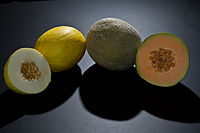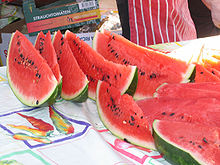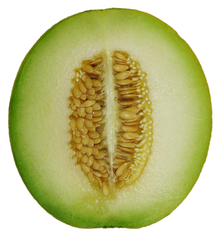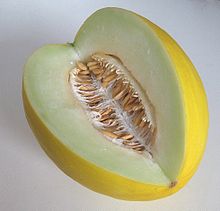- List of melons
-
"Melon" redirects here. For other uses, see Melon (disambiguation).
This list of melons includes members of the plant family Cucurbitaceae with edible, fleshy fruit e.g. gourds or cucurbits. The word "melon" can refer to either the plant or specifically to the fruit. Many different cultivars have been produced, particularly of muskmelons. Although the melon is a botanical fruit, some varieties may be considered culinary vegetables rather than fruits. The word melon derives from Latin melopepo,[1] which is the latinization of the Greek μηλοπέπων (mēlopepon), meaning "melon",[2] itself a compound of μῆλον (mēlon), "apple"[3] + πέπων (pepōn), amongst others "a kind of gourd or melon".[4]
Contents
History
Melons originated in Africa[5] and southwest Asia,[6] but they gradually began to appear in Europe toward the end of the Roman Empire. Melons were among the earliest plants to be domesticated in both the Old and New Worlds.[7] Early American settlers are recorded as growing honeydew and casaba melons as early as the 1600s.[6]
Melons by genus
Benincasa
- Winter melon (B. hispida) is the only member of the genus Benincasa. The mature winter melon is a culinary vegetable, widely used in Asia and India. The immature melons are used as a culinary fruit, for example to make a distinctive fruit drink.
Citrullus
- Egusi (C. lanatus) is a wild melon, identical in appearance to the watermelon. The flesh is inedible, but the seeds are a valuable food source in Africa.[8] Other species that have the same culinary role, and that are also called egusi include Cucumeropsis mannii and Lagenaria sicerari.[9]
- Watermelon (C. lanatus) originated in Africa, where evidence indicates that it has been cultivated for over 4,000 years.[10] It is a popular summer fruit in all parts of the world.[11]
Cucumis
Melons in genus Cucumis are culinary fruits, and include the majority of culinary melons.
- Horned melon (C. metuliferus), a traditional food plant in Africa with distinctive spikes. Now grown in California, Chile, Australia and New Zealand as well.
- Muskmelon (C. melo)
- C. melo cantalupensis, with skin that is rough and warty, not netted.
- The European cantaloupe, with lightly ribbed, pale green skin, was domesticated in the 18th century, in Cantalupo, Italy, by the pope's gardener. Varieties include the French Charentais and the Burpee Seeds hybrid Netted Gem, introduced in the 19th century.[12] The Yubari King is a highly prized Japanese cantaloupe cultivar.
- The Persian melon resemble a large cantaloupe with a darker green rind and a finer netting.[13]
- C. melo inodorus, or winter melons
- Canary melon, a large, bright-yellow melon with a pale green to white inner flesh.
- Casaba, bright yellow, with a smooth, furrowed skin. Less flavorful than other melons, but keeps longer.[14]
- Hami melon, originally from Hami, Xinjian, China. Flesh is sweet and crisp.
- Honeydew, with a sweet, juicy, green-colored flesh. Grown as bailan melon in Lanzhou, China.
- Kolkhoznitsa melon, with smooth, yellow skin and dense, white flesh.[15]
- Navajo Yellow, round or oval with ribbed, yellow skin, and orange flesh.[16]
- Piel de Sapo (toad skin) or Santa Claus melon, with a blotchy green skin and white sweet-tasting flesh.
- Sugar melon a smooth, white, round fruit.[17]
- Tiger melon, an orange, yellow and black striped melon from Turkey with a soft pulp.[18]
- Japanese melons (including the Sprite melon).
- C. melo reticulatus, true muskmelons, with netted (reticulated) skin.
- North American cantaloupe, distinct from the European cantaloupe, with the net-like skin pattern common to other C. melo reticulatus varieties.[19]
- Galia, small and very juicy with either faint green or rosy pink flesh.[13]
- Sharlyn melons, with taste between honeydew and cantaloupes, netted skin, greenish-orange rind, and white flesh.[20]
- Modern crossbred varieties, e.g. Crenshaw (Casaba × Persian), Crane (Japanese × N.A. cantaloupe).
- C. melo cantalupensis, with skin that is rough and warty, not netted.
Momordica
- The bitter melon (M. charantia) is the only melon that is a member of the genus Momordica. It is a culinary vegetable, widely used in Asian, Indian and Caribbean cuisines. The flesh of the bitter melon has a characteristic bitter flavor. In contrast, the red, gelatinous coating of the mature seeds is sweet, and is used in some Asian cuisines as a sweetener. Bitter melon has an unusually large number of common names in various regions.
See also
- List of gourds and squashes
- List of culinary fruits
- Melon baller
- Squash
Notes and references
- ^ Charlton T. Lewis, Charles Short (1879). "melopepo". A Latin Dictionary. Oxford University Press. http://www.perseus.tufts.edu/hopper/text?doc=Perseus%3Atext%3A1999.04.0059%3Aentry%3Dmelopepo.
- ^ Henry George Liddell, Robert Scott (1925). "μηλοπέπων,". A Greek-English Lexicon (ninth ed.). http://www.perseus.tufts.edu/hopper/text?doc=Perseus%3Atext%3A1999.04.0057%3Aentry%3Dmhlope%2Fpwn.
- ^ Liddell et al, "μῆλον"
- ^ Liddell et al, "πέπων"
- ^ John Griffith Vaughan, Catherine Geissler (2009). The new Oxford book of food plants (second ed.). Oxford University Press. p. 134. ISBN 019954946X. http://books.google.com/books?id=UdKxFcen8zgC&lpg=PA134&dq=melons&pg=PA134#v=onepage&q=melons&f=false.
- ^ a b "Growing Melons". University of Nebraska-Lincoln Extension. http://byf.unl.edu/Melon. Retrieved 2011-11-04.
- ^ Andres, T. C. (2004). "Cucurbitaceae". http://www.cucurbit.org/family.html.[self-published source?]
- ^ Danielle Nierenberg. "Seeds, seeds, seeds: Egusi, the Miracle Melon". Nourishing the Planet. http://blogs.worldwatch.org/nourishingtheplanet/seeds-seeds-seeds-egusi-the-miracle-melon/.
- ^ Enoch Gbenato Achigan-Dako; Rose Fagbemissi; Hermane Tonankpon Avohou; Raymond Sognon Vodouhe; Ousmane Coulibaly; Adam Ahanchede (2008). "Importance and practices of Egusi crops (Citrullus lanatus (Thunb.) Matsum. & Nakai, Cucumeropsis mannii Naudin and Lagenaria siceraria (Molina) Standl. cv. ‘ Aklamkpa ’) in sociolinguistic areas in Benin". Biotechnol. Agron. Soc. Environ. 12 (4): 393-40.
- ^ Daniel Zohary and Maria Hopf (2000). Domestication of Plants in the Old World (3 ed.). Oxford University Press. p. 193.
- ^ "Grassland Species Profiles". FAO.
- ^ Anthony F. Chiffolo, Rayner W. Hesse (2006). Cooking with the Bible: biblical food, feasts, and lore. Greenwood Publishing Group. p. 255. ISBN 0313334102. http://books.google.com/books?id=Xwq1lunLkuoC&lpg=PA255&dq=%22melo%20cantalupensis%22&pg=PA255#v=onepage&q=%22melo%20cantalupensis%22&f=false.
- ^ a b Heidemarie Vos (2010). Passion of a Foodie - An International Kitchen Companion. Strategic Book Publishing. p. 348. ISBN 1934925632. http://books.google.com/books?id=spY3ct9PBxEC&lpg=PA348&dq=%22persian%20melon%22%20netting&pg=PA348#v=onepage&q=%22persian%20melon%22%20netting&f=false.
- ^ "What is a casaba melon?". WiseGeek. http://www.wisegeek.com/what-is-a-casaba-melon.htm. Retrieved 2011-11-04.
- ^ "Moscow flooded with melons". The Moscow Times. September 21, 2007. http://www.freshplaza.com/news_detail.asp?id=7938. Retrieved 2001-11-04.
- ^ "Navajo Yellow". Native Seeds. http://www.nativeseeds.org/index.php/store/650/2/seeds/melons/P-navajo-yellow. Retrieved 2011-11-04.[unreliable source?]
- ^ Jac G. Constant (1986). The complete book of fruit: an illustrated guide to over 400 species and varieties of fruit from all over the world. Admiral. p. 35. ISBN 1851710493.
- ^ Judy Bastyra, Julia Canning (1990). A gourmet's guide to fruit. HP Books. p. 64. ISBN 0895868490.
- ^ Linda Ziedrich (2010). The Joy of Jams, Jellies and Other Sweet Preserves: 200 Classic and Contemporary Recipes Showcasing the Fabulous Flavors of Fresh Fruits (Easyread Large Edition). ReadHowYouWant.com. p. 116. ISBN 1458764834. http://books.google.com/books?id=JdLYGMOIndkC&lpg=PA116&dq=reticulatus%20%22north%20american%20melon%22&pg=PA116#v=onepage&q&f=false.
- ^ James Ehler. "Melons". Food Reference. http://www.foodreference.com/html/artmelon.html. Retrieved 2011-11-04.[self-published source?]
General references
- Mabberley, D.J. (1987). The Plant Book. A portable dictionary of the higher plants. Cambridge University Press. pp. 706. ISBN 0-521-34060-8. http://books.google.com/books/about/The_plant_book.html?id=ZVdoUPtqKCIC.
- Magness, J.R., G.M. Markle, C.C. Compton (1971), Food and feed crops of the United States, Interregional Research Project IR-4, IR Bul. 1 (Bul. 828 New Jersey Agr. Expt. Sta.).
Gallery
External links
- "Cucumis melo L.". Purdue University, Center for New Crops & Plant Products. http://www.hort.purdue.edu/newcrop/nexus/Cucumis_melo_nex.html. Retrieved 2011-11-04.
- "Sorting Cucumis names". Multilingual multiscript plant name database. http://www.plantnames.unimelb.edu.au/Sorting/Cucumis.html. Retrieved 2011-11-04.
- Melons, The Cook's Thesaurus, http://www.foodsubs.com/Fruitmel.html, retrieved 2011-11-04. List of photographed varieties of melons.
- "Growing Melons, Makings, Tips - A Grandfather’s Tenets". Melon Growing Guide. Agriculture Guide. June 7, 2011. http://agricultureguide.org/growing-melons-makings-tips-a-grandfathers-tenets. Retrieved 2011-11-04.
Melon Bailan melon • Bitter melon • Canary melon • Cantaloupe • Citron melon • Citrullus ecirrhosus • Cucumeropsis mannii • Galia • Hami melon • Honeydew • Horned melon • Melon ball • Montreal melon • Muskmelon • Paddy melon • Piel de Sapo • Santa Claus melon • Sprite melon • Sugar melon • Sun Melon • Watermelon • Watermelon steak • Winter melon • Yubari KingCategories:- Accessory fruit
- Cucurbitaceae
- Melons
- Greek loanwords
- Lists of foods
Wikimedia Foundation. 2010.











